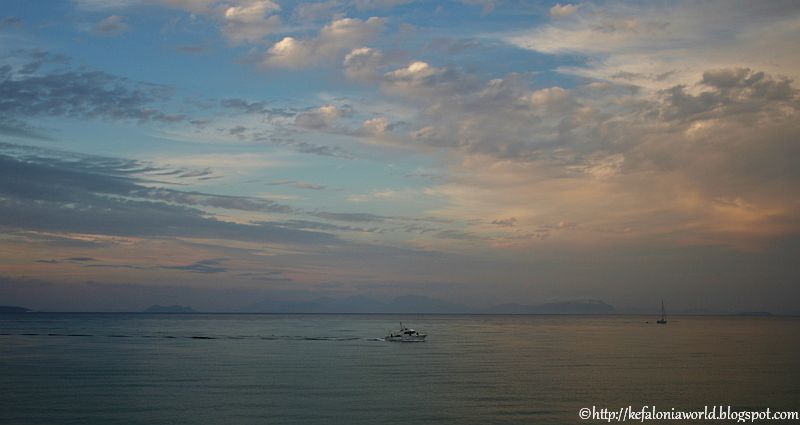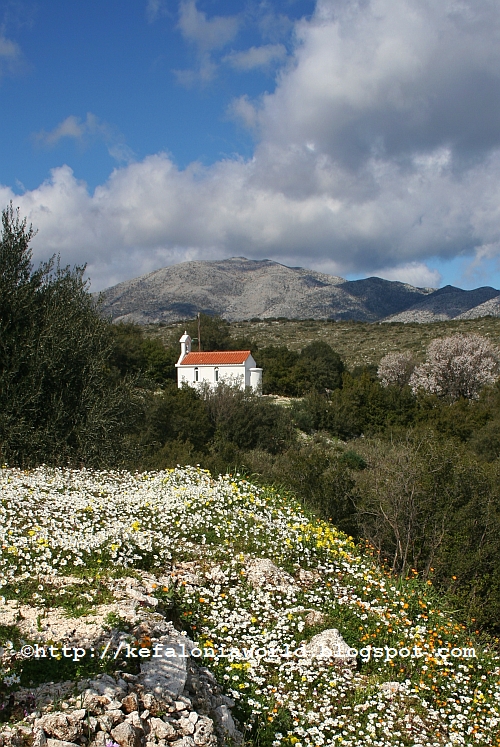Sometimes I get a bit arrogant about knowing everything there is to know about the island. I don't mean the usual
tourist fare, I mean those
it places that make the difference. Fortunately, once in a while I get to eat humble pie—sweet and served up by an old timer, nonetheless.
 |
| Skala, Kefalonia |
Oops! I missed this one
Take the small lookout point over Skala Beach, next to the Roman Villa.
I've passed it by dozens of times, have seen dozens of tourists posing for pictures, and, I've driven on, not giving it a second thought. Just another
miniature square overlooking the sea, right? Let them folks go about their business and I'll go on with mine.
That was my perception of the spot till two years ago, in mid July. I had the privilege of a grand tour of Skala by one who knows it well. Mr. Panagis Travlos, a native of Skala, had served as an officer of the local community and was eager to show me anything and everything I could endure to see before succumbing to the imminent heat stroke. Of course, he treated me as a visitor; being a mere Kefalonian, in the generic sense, did not qualify me as a local!
"Naturally, you know the Vardiola, where Skala's future was decided," he asked in the most casual way.
Now, I can be as quick on the uptake as the next person—even under grueling temperatures—but this one had me baffled.
"Yes, of course," I stuttered, trying to figure out what he was referring to.
No, this is not another miniature square
A
vardiola is a Venetian term for "observatory" and there are quite a few ruins of vardiolas on Kefalonia Island, dating back to the Venetian Era. They are of discernible architecture and are (usually) perched high over the sea. Vardiolas served as lookout posts for observation of the seaways (for pirate vessels, perhaps). In modern times, locations offering a vantage, protected view of the sea are also referred to as vardiolas. I had no idea at the time!
 |
| Skala and beyond |
I get educated by a wise and proud man
So, back in Skala, on that hot July day, I was trying to envision whether I had seen a construction in the area that fit the bill. Mr. Travlos must have noticed my perplexed look and went on to explain as we made our way to the spot I had ignored so many times.
Prior to the devastating earthquakes of 1953, the village of Skala was quite a bit farther up the hillside, it was not a waterfront settlement. Most of the land around the village, including its present location, were potato fields! Yes, at the time, this was Skala's best-known product. The proximity to the sea and the sandy soil make for the most delicious potato variety.
The earthquake left no stone unturned and the citizens of Skala had to decide how and where to rebuild their village. Some wanted to rebuild at the original location so they could be near their fields and stock. Others argued that the village should be moved to the beachfront as this provided ease of access to the water for, among other things, bathing their herds of sheep before the annual shearing! Plus, the threat of a pirate attack was a thing of the past, an advantage not negligible in itself!
According to Mr. Travlos, around the time of the impasse, Skala was visited by the then Minister of Public Works (and later PM and President of the Republic), the late Konstantinos Karamanlis, as head of a commission for the reconstruction of the island.
As he sat to rest at the vardiola's present location and overlooked the span of Skala Beach, he (according to witnesses) said
"You see where the sheep are running free now? I predict that in a decade or two, people from all over Europe will come in hundreds to enjoy this beautiful sea. Yes, the future of Skala is on the water, it is decided."
And so it was decided, and so it was done.
 |
| Overlooking the Ionian Sea from the Vardiola at Skala, Kefalonia |
 |
| Lookout point to all shades of blue |
Lookout to the past and the future
Next time you're in Skala you may want to stop at the Vardiola and try to imagine potato fields behind you (and where the Main Street is today), and sheep sunbathing ahead of you (sans the beach chairs, umbrellas and sunscreens).
Try to visit the old settlement, there are some interesting ruins, a fountain, and some old churches of charming interior design. Though removed from the seafront, the old settlement offers far superior, panoramic, views compared to present-day Skala. And, don't forget to get chummy with a local, he may point you to an establishment that still serves those yummy Skala potatoes. Though the fields are now integrated into the modern settlement infrastructure, there is still limited production, saved to be consumed by family and close friends.
Note: At the risk of dating myself, I'll share with you my first encounter with Skala. I remember hitching a ride with some of my schoolmates, on the back of an open truck that was going to Skala to pick up sacks of its renowned potatoes. My first view of its waterfront was countless sheep sleeping on the beach and under the pine trees. We got scolded upon our return for going, without permission, to a place so secluded that we could never find our way back home had we missed the truck's departure!
Ah, time flies...
And changes everything...




















































